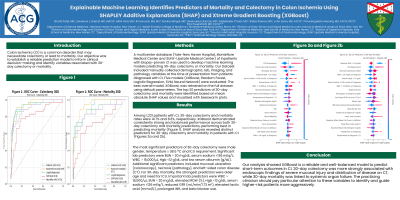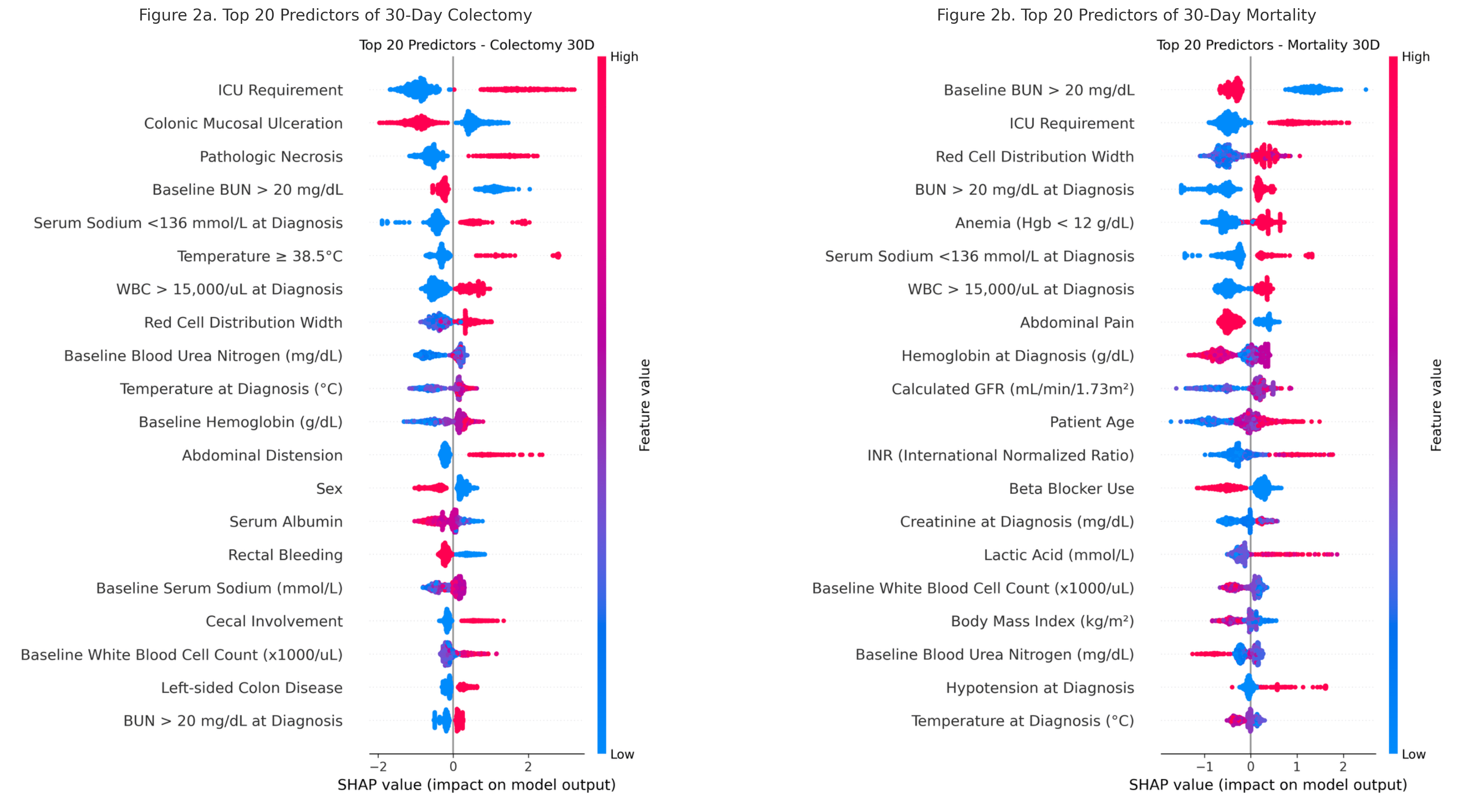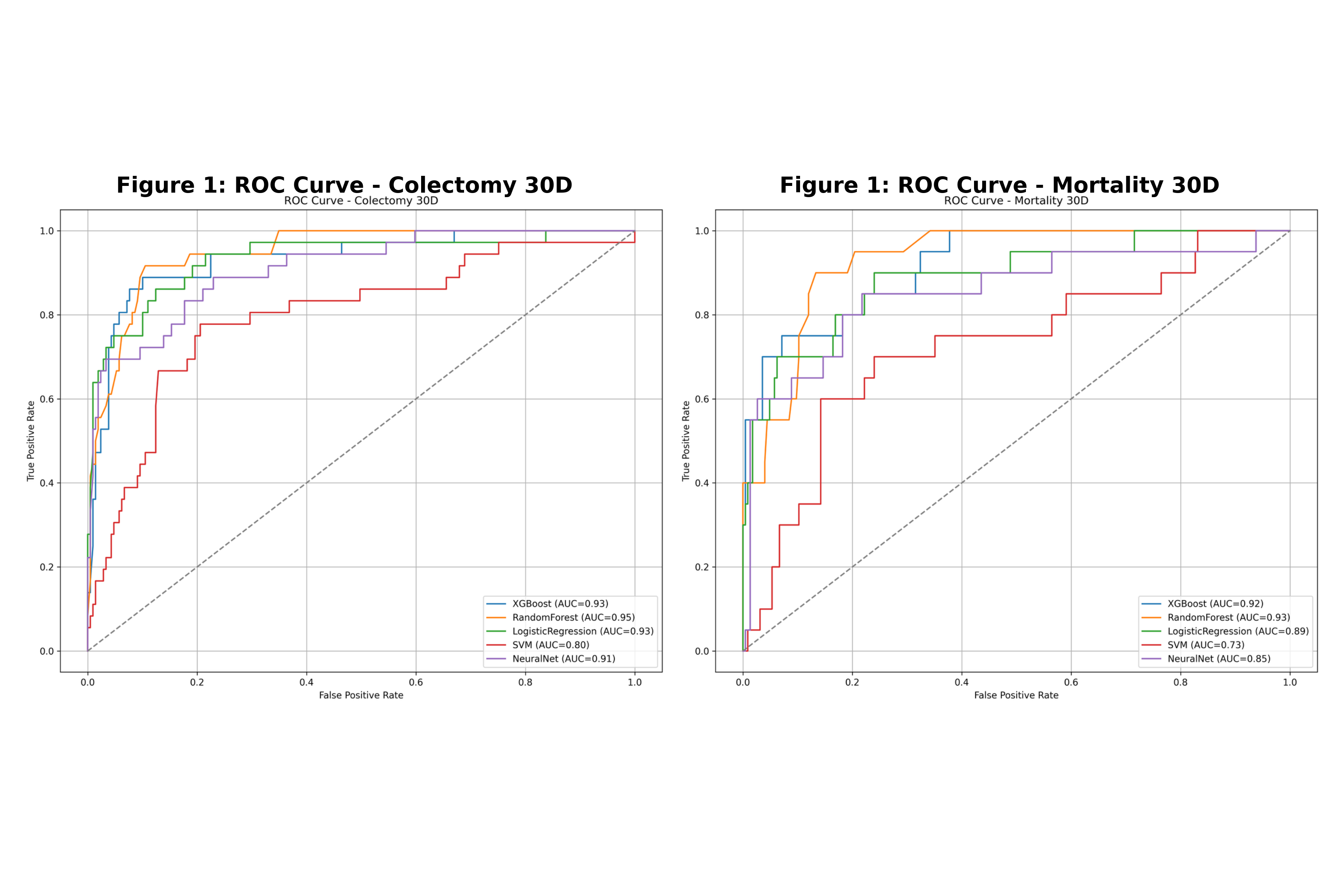Sunday Poster Session
Category: Colon
P0287 - Explainable Machine Learning Identifies Predictors of Mortality and Colectomy in Colon Ischemia Using SHAPley Additive Explanations (SHAP) and Xtreme Gradient Boosting (XGBoost)

.jpg)
Shanti Patel, MD
Yale New Haven Health
New Haven, CT
Presenting Author(s)
Shanti Patel, MD1, Lawrence J. Brandt, MD, MACG2, Akhil Vaid, MD3, Ali Soroush, MD, MS3, Kanika Sehgal, MBBS1, Ikechukwu Elvis Eze, MD4, Abdelkader Chaar, MD5, Rabia Rizwan, MD6, Savio John, MD, FACG5, Thiruvengadam Muniraj, MD4, Paul Feuerstadt, MD, FACG7
1Yale New Haven Health, New Haven, CT; 2Montefiore Medical Center, Bronx, NY; 3Icahn School of Medicine at Mount Sinai, New York, NY; 4Yale University School of Medicine, New Haven, CT; 5SUNY Upstate Medical University, Syracuse, NY; 6Houston Medical Center, Houston, TX; 7Yale University School of Medicine and PACT-Gastroenterology Center, Hamden, CT
Introduction:
Colon ischemia (CI) is a common disorder that may necessitate colectomy or lead to mortality. Our objective was to establish a reliable prediction model to inform clinical decision-making and identify variables associated with 30-day colectomy or mortality.
Methods:
A multicenter database (Yale-New Haven Hosp, Montefiore Med Center, SUNY-Upstate) of inpatients with biopsy-proven CI was used to develop machine learning models predicting 30-day colectomy or mortality. Dataset included manually collected demographic, lab, imaging, and pathology variables at the time of presentation of patients diagnosed with CI. Five models (XGBoost, Random Forest, Logistic Regression, SVM, Neural Network) were evaluated. The best overall model, XGBoost, was retrained on the full dataset using default parameters. The top 20 predictors of 30-day mortality and colectomy were identified based on mean absolute SHAP values and visualized with beeswarm plots.
Results:
Among 1,221 patients with CI, 30-day colectomy and mortality rates were 14.7% and 8.3% respectively. XGBoost demonstrated consistently strong and balanced performance across both 30-day colectomy and mortality predictions, performing best in predicting mortality. (Figure 1). SHAP analysis revealed distinct predictors for 30-day mortality and colectomy in patients with CI (Figures 2a and 2b).
The most significant predictors of 30-day colectomy were male sex, fever ≥ 38.5 °C and ICU need. Key lab predictors were BUN > 20 mg/dL, serum sodium < 136 mEq/L, WBC > 15,000/μL, Hgb < 12 g/dL, and low serum albumin (g/dL). Additional predictors included mucosal ulceration (colonoscopy), necrosis (pathology), and left-sided colon disease (CT). For 30-day mortality, the best predictors were older age and need for ICU. Important lab predictors were WBC > 15,000/μL, BUN > 20 mg/dL, elevated RDW (%), Hgb < 12 g/dL, serum sodium < 136 mEq/L, reduced GFR (mL/min/1.73 m²), elevated lactic acid (mmol/L), prolonged INR, and beta blocker use.
Discussion:
Our analysis showed XGBoost is a reliable and a well-balanced model to predict short-term outcomes in CI. 30-day colectomy was more strongly associated with endoscopic findings of severe mucosal injury and distribution of disease on CT, while 30-day mortality was linked to systemic organ failure, e.g., critical care need, renal impairment, metabolic derangement, and coagulopathy. Attention to these variables can potentially guide clinicians in managing higher -risk patients more aggressively to possibly improve outcomes.


Disclosures:
Shanti Patel, MD1, Lawrence J. Brandt, MD, MACG2, Akhil Vaid, MD3, Ali Soroush, MD, MS3, Kanika Sehgal, MBBS1, Ikechukwu Elvis Eze, MD4, Abdelkader Chaar, MD5, Rabia Rizwan, MD6, Savio John, MD, FACG5, Thiruvengadam Muniraj, MD4, Paul Feuerstadt, MD, FACG7. P0287 - Explainable Machine Learning Identifies Predictors of Mortality and Colectomy in Colon Ischemia Using SHAPley Additive Explanations (SHAP) and Xtreme Gradient Boosting (XGBoost), ACG 2025 Annual Scientific Meeting Abstracts. Phoenix, AZ: American College of Gastroenterology.

